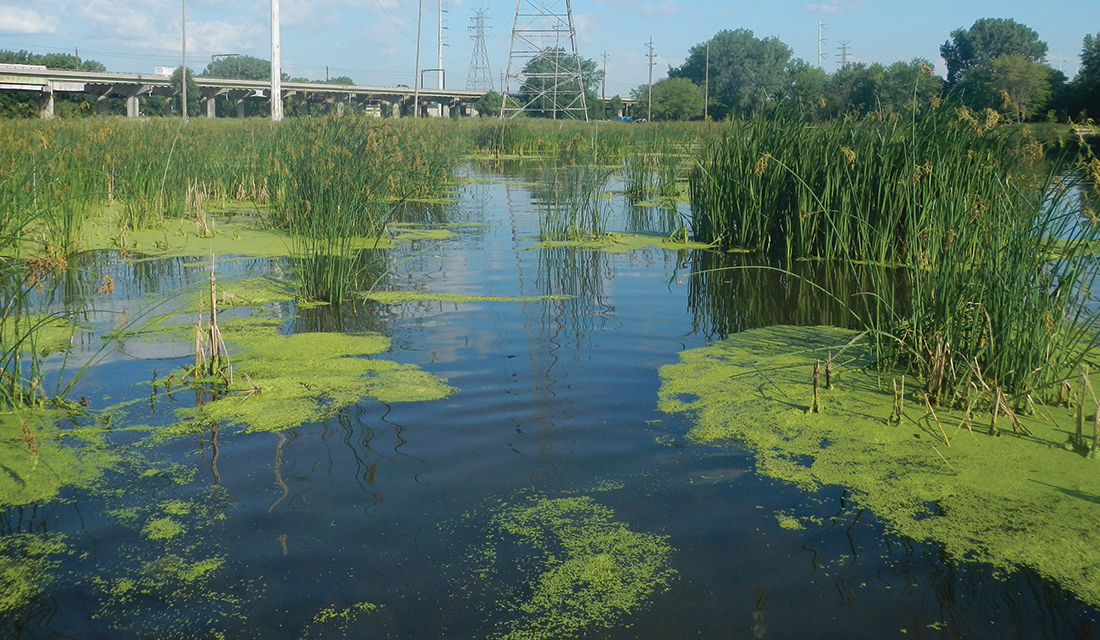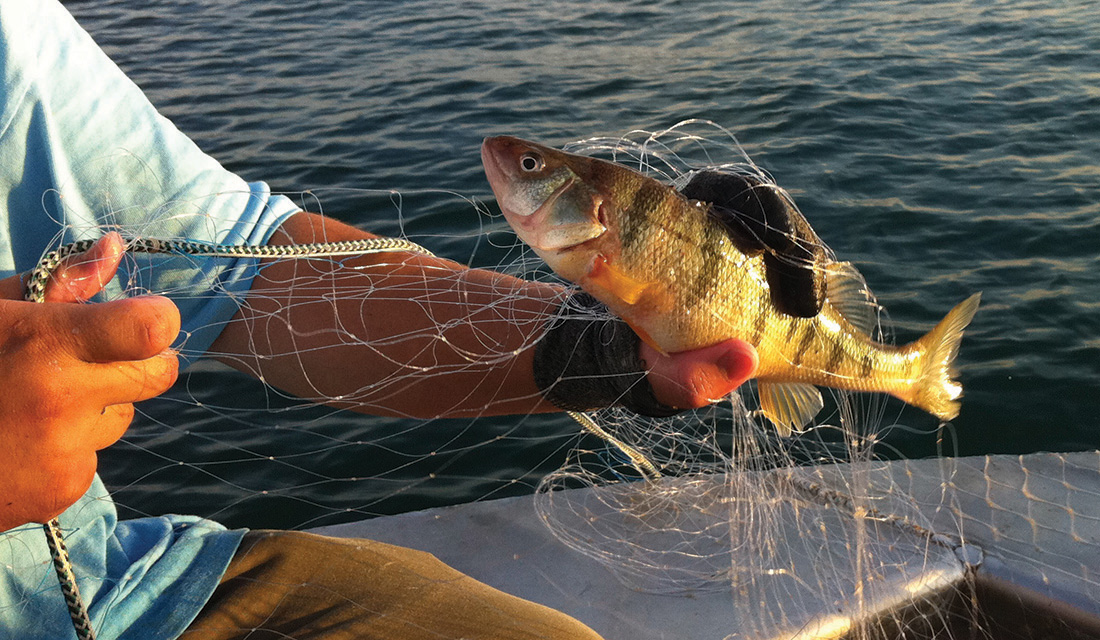This story appears in Lake Michigan nearshore food web: Charting new waters, a new publication created by Illinois-Indiana Sea Grant and Wisconsin Sea Grant.
While the influx of invasive species has taken a toll on the Lake Michigan food web, the loss of habitats like coastal wetlands may be having impacts too. Researchers who are looking at how coastal wetlands contribute to lake habitats have, thus far, documented that various fish species like yellow perch and smallmouth bass use these wetlands at various points in their lives.
Biologists Gary Lamberti, University of Notre Dame, and Patrick Forsythe, University of Wisconsin-Green Bay, are leading a team whose goal is to quantify the role of coastal wetlands in sustaining sportfish. The project is in progress, but is making promising steps forward.
They are building the food web in wetland and nearshore habitats at nine paired wetland-nearshore sites around Lake Michigan, with the wetlands representing a variety of landscapes and distances from the lake. The scientists are using three measures from 50 species of fish, both prey and predators, to map out the story. The first two measures are commonly used—carbon and nitrogen stable isotopes. Carbon isotopes reveal location in terms of food source. It reveals what the base of the food web looks like.

The newly restored Roxana Marsh in Indiana provides a study site for assessing the importance of wetlands to Lake Michigan sportfish.
“In a wetland, carbon cycling happens faster than in nearshore waters so the carbon signature is more depleted and that gets propagated up the food chain,” said Katherine O’Reilly, who has taken on this work as part of her doctorate at Notre Dame.
The nitrogen isotope indicates where a species sits in the food chain and can reveal what species are more predatory and are eating other fish versus those that are primary consumers, eating solely invertebrates or zooplankton.

Nearshore areas, including wetlands, may play important roles to yellow perch and other sportfish.
The third measure is a technique first pioneered in marine studies. The researchers are analyzing trace element chemistry of otoliths, which are fish ear bones. Since they are always growing, otoliths provide a timeline of where the fish have been.
“The otolith is comprised of trace elements in the water and we’ve learned that water samples from wetlands and the nearshore are very different,” said O’Reilly. “We have found in the otolith that the fish are using wetlands at different times in their life cycles. This preliminary look at the microchemistry reveals that important sportfish like yellow perch and walleye are not staying in one habitat,” said O’Reilly. “They are moving energy between wetland and nearshore waters.”
As analysis progresses further, the researchers will be able to understand more about the connection between the two habitats. Ultimately, they are hoping to demonstrate the value of wetlands to the lake food web and sportfish.
“The question might need to be answered: How much is a wetland worth to a fishery?” said O’Reilly.
Illinois-Indiana Sea Grant is a part of University of Illinois Extension and Purdue University Extension.
Congratulations to Monica Gregory, Illinois-Indiana Sea Grant’s first NOAA Coastal Management Fellow.
The Coastal Management Fellowship was established to provide on-the-job education and training opportunities in coastal resource management and policy for postgraduate students and to provide project assistance to state coastal zone management programs. The program matches postgraduate students with state coastal zone programs to work on projects proposed by the state.
Starting in August, Monica will be working with the North Carolina Division of Coastal Management, aiding in the assessment of the hazard vulnerability for communities living on the coast, and their needs for support in improving their resilience. She received a Master’s degree in public affairs from Indiana University this past spring.
“I am incredibly excited to be a part of this fellowship, and more specifically to be a part of the project in North Carolina. My graduate studies focused on social and ecological resilience in the face of a rapidly changing environment, with a focus on vulnerable coastal communities,” said Monica.
“This fellowship is a dream come true!”
Illinois-Indiana Sea Grant is a part of University of Illinois Extension and Purdue Extension.
As the 2014 Knauss season wraps up, IISG-sponsored graduate student Katherine Touzinsky wrote in to update us on her work at the U.S. Army Corps of Engineers since we last heard from her in August.
The last time I wrote for the IISG blog, I was overwhelmed with gratitude for how far the Knauss Fellowship had taken me—both figuratively through professional and personal development and literally by zig-zagging across the country. Since then, the travel and learning has not slowed down. I have eaten lunch on a dredging rig in the Gulf of Mexico, visited a research laboratory in Athens, Greece, attended a conference on deltas and climate change in the Netherlands, and explored the Everglades learning about the impending consequences of invasive species and climate change.
 The fellowship is now coming to a close, and the tides are changing at work. The open-ended learning ended a few months ago when I committed the majority of my time to a new and exciting project with the U.S. Army Corps of Engineers.
The fellowship is now coming to a close, and the tides are changing at work. The open-ended learning ended a few months ago when I committed the majority of my time to a new and exciting project with the U.S. Army Corps of Engineers.
Ever since the devastation of 2011, when over 14 weather and climate-related events—Hurricane Sandy being the most noteworthy—resulted in an unprecedented loss of lives and property, many federal agencies have begun their own investigation of climate change and disaster preparedness under the broad headline of “resilience.”
Resilience is an ambiguous word that can mean different things depending on the case and application, but most definitions include four key aspects: prepare, resist, recover, and adapt. Because the Corps is in charge of the nation’s water resources infrastructure, there is a huge need to investigate these concepts and research the best way to apply resilience to Corps policy and practice. I have been offered the opportunity to assist with much of this initial research. While it is intimidating to face such a huge issue and figure out how to recommend solutions for such a huge and venerable organization like the Corps, I wake up every day excited to learn more.
This coming February, we are working on a joint U.S. Army Corps and NOAA workshop to quantify resilience in Mobile Bay, AL. I will help test the method by working with community experts from the Mississippi-Alabama Sea Grant Consortium and the local port authorities to be vetted later this spring by the National Academy of Sciences Transportation Research Board.
Despite all of this excitement, I know that my Master’s thesis is still waiting for me. Luckily, I have been given the opportunity to continue working in Washington D.C. at the Corps headquarter office and will work part-time on my thesis. I’m brainstorming possible locations to work on the thesis—it would be great to say that I wrote a chapter or two in the Library of Congress!
The Knauss Fellowship has been an unbelievable opportunity that continues to unfold!



